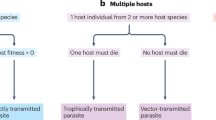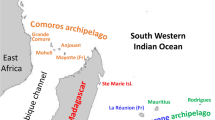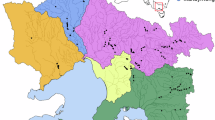Summary
In this paper isoenzyme variation in six species of Australian reptile ticks is used to examine a hypothesis, proposed by Price (1977), that populations of parasites will diverge more rapidly from each other than populations of non-parasites. The data support Price's prediction that parasite populations have low levels of genetic variability. The average heterozygosity per locus was less than 2·5 per cent in each reptile tick species, compared with a mean value of 11·23 per cent for 93 non-parasitic invertebrates (Nevo 1978). Price also predicted large genetic variation between parasite populations, but this was not normally the case within reptile tick species. Where genetic distance was large between populations it could be explained by processes which were not unique to parasites.
Similar content being viewed by others
Article PDF
References
Adams, M, Baverstock, P R, Saunders, D A, Schodde, R, and Smith, G T. 1984. Biochemical systematics of the Australian cockatoos (Psittaciformes: Cacatuinae). Aust J Zool, 32, (in press).
Andrews, R H, and Bull, C M. 1983. Premating behaviour in the Australian reptile tick Aponomma hydrosauri. Anim Behav, 28, 1280–1286.
Andrews, R H, and Bull, C M. 1983. Premating reproductive isolation between geographically isolated populations of an Australian reptile tick. J Parasitol, 69, 1125–1130.
Avise, J C, and Aquadro, C F. 1982. A comparativie survey of genetic distances in the vertebrates. Evolut Biol, 15, 151–185.
Ayala, F J. 1975. Genetic differentiation during the speciation process. Evolut Biol, 8, 1–78.
Baverstock, P R, Watts, C H S, and Cole, S R. 1977a. Electrophoretic comparisons between allopatric population of five Australian Pseudomyine rodents (Muridae). Aust J Biol Sci, 30, 471–485.
Baverstock, P R, Watts, C H S, and Cole, S R. 1977b. Inheritance studies of glucose phosphate isomerase, transferrin and esterases in the Australian hopping mice, Notomys alexis, N. cervinus, N. mitchellii and fuscus (Rodentia: Muridae). Anim Blood Groups Biochem Genet, 8, 3–12.
Baverstock, P R, Watts, C H S, Adams, M, and Gelder, M. 1980. Chromosomal and electrophoretic studies of Australian Melomys (Rodentia: Muridae). Aust J Zool, 28, 289–303.
Bull, C M. 1978a. Heterogeneity of resource utilization in a population of the Australian reptile tick, Aponomma hydrosauri (Denny). Ecol Entomol, 3, 171–179.
Bull, C M. 1979b. Dispersal of the Australian reptile tick Aponomma hydrosauri by host movement. Aust J Zool, 26, 689–697.
Bull, C M, and Sharrad, R D. 1980. Seasonal activity of the reptile tick, Aponomma hydrosauri (Denny) (Acari: Ixodidae) in experimental enclosures. J Aust Entomol Soc, 19, 47–52.
Bull, C M, Sharrad, R D, and Petney, T N. 1981. Parapatric boundaries between Australian reptile ticks. Proc Ecol Soc Aust, 11, 95–107.
Daugherty, C H, Bell, B D, Adams, M, and Maxson, L R. 1981. An electrophoretic study of genetic variation in the New Zealand frog genus Leiopelma. New Zealand J Zool, 8, 543–550.
Glauert, L. 1981. A Handbook of the Lizards of Western Australia. W.A. Naturalists Club, Perth.
Gorman, G C, and Renzi, J. 1979. Genetic distance and heterozygosity estimates in electrophoretic studies: effects of sample size. Copeia, 1979, 242–249.
Healy, J A. 1979a. Phosphoglucomutase polymorphism in the tick Ixodes ricinus. Parasitology, 78, 7–18.
Healy, J A. 1979b. Analysis of α-glycerophosphate dehydrogenase variability in the tick Ixodes ricinus (Acari: Ixodidae). Genetica, 50, 19–30.
Johnson, G B. 1974. Enzyme polymorphism and metabolism. Science, 184, 28–37.
Johnson, G B. 1976. Hidden alleles at the α-glycerophosphate dehydrogenase locus in Colias butterflies. Genetics, 83, 149–167.
Levins, R. 1968. Evolution in Changing Environments. Princeton University Press, Princeton, N.J.
Milne, A. 1945. The ecology of the sheep tick, Ixodes ricinus L. Host availability and seasonal activity. Parasitology, 36, 153–157.
Milne, A. 1948. The ecology of the sheep tick, Ixodes ricinus L. Host relationships of the tick. Part 2. Observations on hill and moorland grazing in northern England. Parasitology, 39, 173–197.
Nei, M. 1972. Genetic distance between populations. Amer Nat, 106, 283–291.
Nei, M. 1978. Estimation of average heterozygosity and genetic distance from a small number of individuals. Genetics, 89, 583–590.
Nevo, E. 1978. Genetic variation in natural populations: patterns and theory. Theor Pop Biol, 13, 121–177.
Oliver, J H, and Bremer, K C. 1968. Cytogenetics of ticks. III. Chromosomes and sex determination in some Australian hard ticks (Ixodidae). Ann Entomol Soc Amer, 61, 837–844.
Petney, T N, and Bull, C M. 1981. A non-specific aggregation pheromone in two Australian reptile ticks. Anim Behav, 29, 181–185.
Petney, T N, Andrews, R H, and Bull, C M. 1983. Movement and host finding by unfed nymphs of two Australian reptile ticks. Aust J Zool, 31, 717–721.
Petney, T N, Bull, C M, and Andrews, R H. 1982. A stable boundary between two species of reptile ticks on Eyre Peninsula, South Australia. Trans Roy Soc S Aust, 106, 159–161.
Price, P W. 1977. General concepts on the evolutionary biology of parasites. Evolution, 31, 405–420.
Richardson, B J, and McDermid, E M. 1978. A comparison of genetic relationships within the macropodidae as determined from allozyme, cytological and immunological data. Aust Mammal 2, 43–51.
Roberts, F H S. 1970. Australian Ticks. C.S.I.R.O., Melbourne.
Satrawaha, R, and Bull, C M. 1981. The area occupied by an omnivorous lizard, Trachydosaurus rugosus. Aust Wildl Res, 8, 435–442.
Sharrad, R D. 1980. Studies of the factors which determine the distributions of three species of South Australian ticks. Ph.D. thesis, University of Adelaide.
Sharrad, R D, and King, D R. 1981. The geographical distribution of reptile ticks in Western Australia. Aust J Zool, 29, 861–873.
Sneath, P H A, and Sokal, P R. 1973. Numerical Taxonomy. W. H. Freeman, San Francisco.
Trevorrow, R L, Stone, B F, and Cowio, M. 1977. Aggregation pheromones in two Australian hard ticks, Ixodes holocyclus and Aponomma concolor. Experientia, 33, 680–682.
Author information
Authors and Affiliations
Rights and permissions
About this article
Cite this article
Bull, C., Andrews, R. & Adams, M. Patterns of genetic variation in a group of parasites, The Australian reptile ticks. Heredity 53, 509–525 (1984). https://doi.org/10.1038/hdy.1984.112
Received:
Issue date:
DOI: https://doi.org/10.1038/hdy.1984.112
This article is cited by
-
Allozyme polymorphism of Mdh and α-Gpdh in Ixodes ricinus populations: comparison of borreliae-infected and uninfected ticks
Experimental and Applied Acarology (2006)
-
Amblyomma vikirri n. sp. (Acari: Ixodida: Ixodidae), a parasite of the gidgee skinkEgernia stokesii (Reptilia: Scincidae) from South Australia
Systematic Parasitology (1996)
-
Cuticular hydrocarbon composition and phenotypic variability in sympatric populations of Ixodes ricinus ticks from Poland
Experimental and Applied Acarology (1994)
-
Cuticular hydrocarbon gas chromatography analysis of Argas vulgaris, A. polonicus, and their hybrids
Experimental and Applied Acarology (1993)
-
Electrophoretically detectable protein variation in natural populations of the lone star tick, Amblyomma americanum (Acari: Ixodidae)
Heredity (1986)



